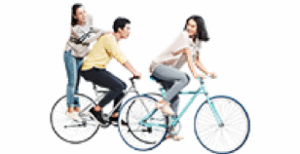Bicycles
Like you, cyclists have laws and rules they must observe when on the streets. Some will and, unfortunately, some won’t. Even if you are not a cyclist, knowing the rules they’re required to follow can help you to anticipate potential risks when you encounter bicycles along the roads.
So, note these bicycle rules:
- Always operate a bicycle as close as possible to the right side of the road unless you are passing another vehicle or planning to make a left turn.
- Cyclists can also pull out and away from the curb a bit to avoid pedestrians, potholes, open car doors, or other hazards.
- In Alabama, the maximum number of cyclists allowed to ride side by side is two.
- Cyclists in the flow of traffic must use the same hand signals for the same purposes as do vehicle drivers. This includes turns, lane changes, and stops.
- Bicyclists are not allowed to ride on sidewalks.
- Many areas have marked bicycle lanes. These lanes are typically marked with a bicycle silhouette and separated from vehicle traffic with a painted line. They may also be marked with signs. In such areas, cyclists must use those lanes.
- Cyclists under age 16 must wear a helmet when operating a bicycle.
- Bicycles must be outfitted with lights and/or reflectors for riding after dark.
Now that you know what rules the cyclist must follow,
how should you act when driving near bicyclists?
- Vehicle drivers must never enter a bike lane unless you are crossing it to make a right turn or exit a highway. Whenever you make a right turn at an intersection, check for cyclists on your right. You may inadvertently cut them off during your turn if you don’t. To avoid this, move into the bike lane just before your turn, being sure not to force any cyclist to avoid you or stop.
- You may park in a bike lane if parking is permitted in that area.
- Allow at least three feet of distance between you and any cyclists you pass on the road. Just as a large truck can cause a draft that will affect you, your vehicle can cause enough of a gust to upend a cyclist. Also use extreme caution as you pass. A cyclist can slip and fall on loose pebbles or sand on the pavement. A small pothole can cause the bicyclist to lose control and fall into your path. A small child or loose pet can cause a bicyclist to react quickly and steer out into your path without thinking. In wet weather, bicycle tires can lose traction just as easily as can vehicle tires.
- Never try to pass a cyclist if it is not safe. Use the same guidelines you do when passing other vehicles. Never pass near curves or hills or when your view ahead is even partially obstructed. Don’t pull into the lane of oncoming traffic to pass. If you must wait and follow a cyclist before you can pass by, do not lose your patience. Give the cyclist room and wait until it becomes safe to make your passing move.
- Cyclists operate at all hours. Despite the fact that their bikes must be equipped with lights or reflectors, many cyclists do not have such devices on their clothing. Many actually wear dark clothing. Be extra cautious at night, especially if you know the area and know that you may encounter bicycles. Be just as cautious in any situation where visibility is poor.
- Heavy traffic or parked cars can make if tougher to see bicyclists. Again use extra caution in these areas as well as near intersections and side streets. When you pull into traffic you are not just watching for oncoming vehicles. You need to be on the lookout for bikes and pedestrians as well.
Who do you think will come out better in a collision
between a motor vehicle and a bicycle?
Regardless of whose fault the collision is, the vehicle driver will usually come out on top. Even if you are not injured in a vehicle to bicycle collision, how long will you live with the guilt if a cyclist is injured or worse?
